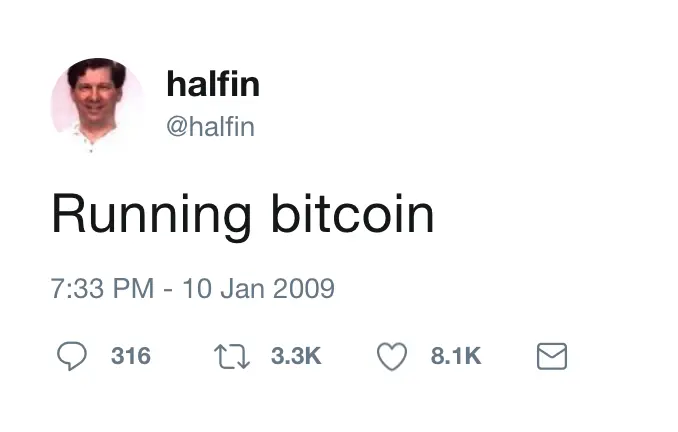Satoshi Nakamoto is the anonymous creator(s) of Bitcoin who published the whitepaper on October 31, 2008 and mined the first Bitcoin block on January 3, 2009. Before ultimately disappearing, Satoshi developed Bitcoin and mined an estimated 1 million BTC, which remain untouched to this day. Satoshi’s disappearance ensured Bitcoin’s decentralization, a source of strength in the eyes of most Bitcoiners.
This article explores Satoshi’s role in developing Bitcoin, the significance of Satoshi’s disappearance, and Satoshi’s legacy.
Development of Bitcoin
Satoshi is credited as being the sole developer of Bitcoin prior to its release, and author of the Bitcoin Whitepaper. According to an email to the Cryptography Mailing List, Satoshi spent roughly 18 months developing the initial version of Bitcoin before sharing the Bitcoin Whitepaper with the mailing list.
The first version of Bitcoin (Bitcoin v0.1) was released on SourceForge, a platform for managing and hosting open-source software projects. After its launch, Bitcoin’s initial discussions and development occurred on SourceForge.
Satoshi later founded Bitcointalk.org in 2010 as the primary hub for discussions around Bitcoin development and community building.
In 2010, Satoshi handed over control of the Bitcoin source code repository and other critical resources to Gavin Andresen, an early Bitcoin developer. This transition was accompanied by Satoshi’s gradual reduction in communication with the community.
Around the same time, Bitcoin development moved to GitHub. In 2013, the primary implementation of Bitcoin was renamed Bitcoin Core.
Today, Bitcoin Core is maintained by the open-source community and is not controlled by any single company, group, or individual. Over 1,000 developers have contributed to the project.
Timeline of Satoshi Nakamoto

April 5, 1975: Satoshi’s Symbolic Birthday
Satoshi’s profile on P2P Foundation—the forum used to share and discuss Bitcoin—lists April 5, 1975, as his birthday.
This date is believed to be a reference of Executive Order 6102, a decree issued by President Roosevelt on April 5, 1933, prohibiting the private ownership of gold, which was later repealed in 1975.

May 2007: Satoshi Begins Development of Bitcoin
In developing Bitcoin, Satoshi aimed to create a form of money allowing for digital payments without a trusted third party. This required addressing two problems that previous digital currencies had failed to solve.
- The Byzantine Generals Problem, which describes the difficulty decentralized parties have in arriving at consensus in a game theoretically safe manner. To solve this problem, all parties must agree on a method of trustlessly determining truth.
- The double spend problem: how can a receiver of digital money be sure that the money they were sent was not simultaneously sent to someone else? How can all members of a monetary network be sure others are not duplicating their money at will?
Satoshi’s invention of Bitcoin was the outcome of decades of advancements in cryptography and previous iterations of digital money. Bitcoin’s process for ensuring that only the rightful owner can spend their bitcoin, the Elliptic Curve Digital Signature Algorithm, relies on elliptic curve cryptography. The idea and mechanics of elliptic curve cryptography were proposed by mathematicians in 1985.
Another crucial piece of Bitcoin’s technology is Proof-of-Work. This technology is the backbone of Bitcoin’s mining operations, a necessary component of the Bitcoin network’s functionality. Proof-of-Work systems were developed progressively throughout the 1990’s with the biggest leaps being Wei Dai’s b-money in 1998 and Adam Back’s Hashcash in 1997.

August 8, 2008: Bitcoin.org Domain Registered
Bitcoin.org was registered by Satoshi Nakamoto and Martti Malmi, an early bitcoin developer. The website still serves as an introductory and educational platform for Bitcoin and hosts the Bitcoin Whitepaper.
October 31, 2008: Bitcoin Whitepaper Published
Satoshi first shared the Bitcoin Whitepaper with the Cryptography Mailing List with the message, “I’ve been working on a new electronic cash system that’s fully peer-to-peer, with no trusted third party.”
The release occurred at the height of the Great Financial Crisis, just weeks after the collapse of Lehman Brothers and the first government bailouts.
The initial reaction to the whitepaper’s release was mixed. Many members were skeptical of Bitcoin’s ability to solve the double spend problem without a centralized authority.
Notably, Hal Finney, a respected cryptographer, was an early supporter and became one of the first people to run a Bitcoin node.
January 3, 2009: Genesis Block Mined
Satoshi mined the first Bitcoin block, known as the “Genesis Block”, marking the start of the Bitcoin blockchain and serving as its foundation.
The genesis block contains a single transaction, a mining reward of 50 bitcoin to Satoshi. It also contains an embedded message from The Times newspaper, which serves as both a timestamp of the genesis block, and a subtle critique of the financial system.

January 9, 2009: Bitcoin v0.1 Released
The initial software release of Bitcoin occurred on SourceForge, along with instructions and documentation for running Bitcoin.
January 12, 2009: First Bitcoin Transaction Sent
Satoshi sent the first bitcoin transaction to Hal Finney, consisting of 10 bitcoin. At the time, bitcoin had no monetary value, making this transaction purely a demonstration of Bitcoin’s functionality.
February 24, 2010: Bitcoin Logo Proposed
The first Bitcoin logos were created by Satoshi. In February 2010, Satoshi proposed the iconic “₿”, which was updated to the now current orange logo later that year.
Bitcoin’s current logo was first proposed on November 1, 2010, by a pseudonymous cryptographer named “Bitboy” who shared the image on Bitcointalk.

December 2010 - April 2011: Satoshi’s Disappearance
Throughout 2010, Satoshi gradually distanced from Bitcoin discourse, as more users and developers began participating in discussion and development. This shift coincided with increasing attention on WikiLeaks, a platform for publishing leaked documents, which had started accepting Bitcoin payments and drawn heightened scrutiny from governments.
Satoshi’s last blog post on Bitcointalk.org occurred on December 12, 2010. By that time, Gavin Andresen had already become a core contributor to Bitcoin, with access to its codebase and experience in developing existing versions.
On April 23, 2011, Satoshi’s last known communication was sent via email to Bitcoin Developer Mike Hearn. In the email, he formally stepped away from the project by saying “I’ve moved on to other things. It’s in good hands with Gavin and everyone.”
Disappearance and Anonymity
Satoshi’s disappearance and lasting anonymity were critical to the early success of Bitcoin, and key factors that separate Bitcoin from all other cryptocurrencies. This disappearance has had several lasting effects:
- Decentralization: Satoshi’s absence ensured that Bitcoin is not controlled by a single leader. Instead, the project has since been maintained by the open-source community, with no single point of failure. Bitcoin’s decentralization has made it immune to control by any single group, company, or government. By consequence, the rules of the protocol remain transparent and predictable for everyone.
- Open-source development: Satoshi’s disappearance encouraged a collaborative approach to Bitcoin development, which is handled by the open-source community.
- Economic implications: Satoshi’s bitcoin holdings have not been moved or transferred since his disappearance. If Satoshi is indeed gone forever, his holdings can be considered “lost”. This has large economic implications, as lost bitcoin reduces the total spendable supply of bitcoin, making the remaining bitcoin more scarce.
How Much Bitcoin Does Satoshi Have?
In Bitcoin’s early days, Satoshi was one of the few active miners, earning rewards of 50 BTC for each block mined. By the time of Satoshi’s disappearance in 2011, over 6 million bitcoin had been mined. Undoubtedly much of this supply had been mined by Satoshi.
According to analysis of miner hashing by Sergio Demian Lerner, Satoshi likely mined around 968,000 bitcoin in 2009, making him the single largest bitcoin holder to this day.
Satoshi’s Identity
The mystery of Satoshi Nakamoto’s true identity has intrigued the world since the creation of bitcoin. It is unknown whether Satoshi is an individual, group of people, or a larger organization. While there is no indication of Satoshi’s true identity, Satoshi’s actions provide some behavioral patterns:
- Time of activity: Analysis of Satoshi’s activity on SourceForge, Bitcointalk, and other websites suggests that Satoshi may have lived in areas in Greenwich Mean Time (GMT), Eastern (EST), or Mountain (MST) time zones.
- Language: Satoshi’s writing style and language have been highly scrutinized in attempts to reveal his true identity. Satoshi displayed a few unique grammar and language patterns, such as double-spacing after each sentence and British word choices such as “bloody” and “maths”.
- Coding expertise: Satoshi wrote Bitcoin in the C++ language. While the original version had very few bugs, some claim it was not written in a modern style, evidenced by a lack of abstractions between components, no published tests, and an outdated style.
The true identity of Satoshi Nakamoto has been the subject of widespread speculation, with several prominent figures proposed as potential candidates, including:
- Hal Finney: As the first vocal supporter of Bitcoin and the first recipient of a transaction, many have pointed to Hal Finney as the likely figure behind Satoshi. However, analysis by Jameson Lopp has debunked this claim, with evidence including the fact that Finney was running a 10 mile race at the same time Satoshi was responding to emails in 2009.
- Nick Szabo: Szabo is a well-known cryptographer and creator of Bitcoin predecessor Bit Gold in 1998. Evidence that Szabo is Satoshi includes a similar writing style, a period of inactivity between 2008 and 2009, and an ideological alignment on the need for systems that eliminate the need for trusted intermediaries. However, Nick Szabo has explicitly denied claims of being Satoshi Nakamoto.
- Peter Todd: Todd is a well-known Bitcoin developer who first became involved in the project in 2010. An HBO documentary in 2024 claims that Todd is Satoshi, a theory relying on a single chat message written by Todd. However, Peter Todd has denied these claims and points to the fact that he was still in college when the Bitcoin whitepaper was published.
- The US Government: Some claim that Bitcoin was a government project made with the intention of controlling money on a global scale. Federal agencies such as the NSA and Darpa have spearheaded advancements in cryptography and played a controversial role in weakening certain cryptographic standards.
- Craig Wright: ** ** Wright, an Australian computer scientist and businessman, publicly declared himself to be Satoshi in 2016. However, he failed to provide evidence to this claim by signing one of Satoshi’s public keys. Craig Wright’s claim to be Satoshi was finally dismissed by the UK High Court in March, 2024.
Satoshi’s Legacy
Satoshi Nakamoto will be remembered as a visionary in monetary philosophy, cryptography, and decentralized technology. Satoshi’s disappearance is one of history’s great mysteries, and is seen as a selfless action meant to ensure the success of a new form of money.
In recent years, statues of Satoshi have been erected across the globe to honor his contributions to humanity, such as two pictured below in Budapest, Hungary (left) and Lugano, Switzerland (right).

The atomic unit of Bitcoin was named after Satoshi, often abbreviated to “sats”. A single Bitcoin represents 100 million satoshis (1 BTC = 100,000,000 sats). Thus, there will only ever be 21 million bitcoin, and there will only ever be 2.1 quadrillion sats. This feature makes Bitcoin more divisible, enabling payments smaller than $0.01 at current prices.
Lastly, if Satoshi is an individual and still alive today, his bitcoin holdings, valued at nearly $100 billion, would make him one of the wealthiest people on earth.
Key Takeaways
- Satoshi Nakamoto is the anonymous creator(s) of Bitcoin who published the whitepaper on October 31, 2008 and mined the first Bitcoin block on January 3, 2009.
- Satoshi’s disappearance and lasting anonymity were critical to the early success of Bitcoin, and key factors that separate Bitcoin from all other cryptocurrencies.
- It is unknown whether Satoshi is an individual, group of people, or a larger organization.



